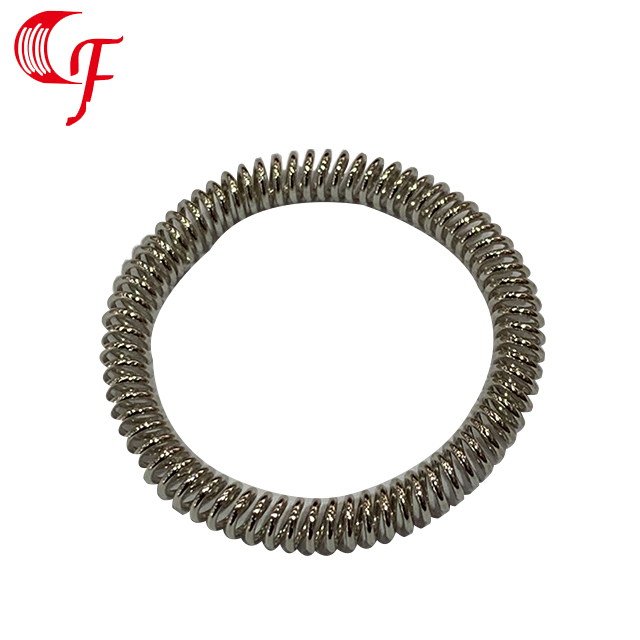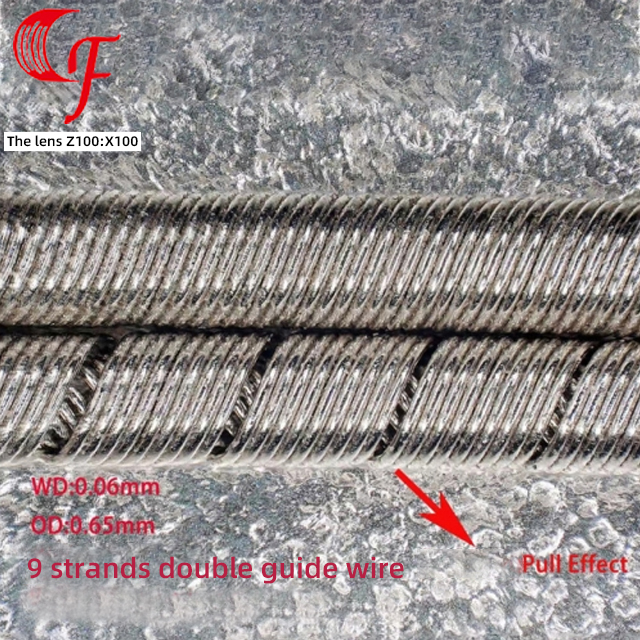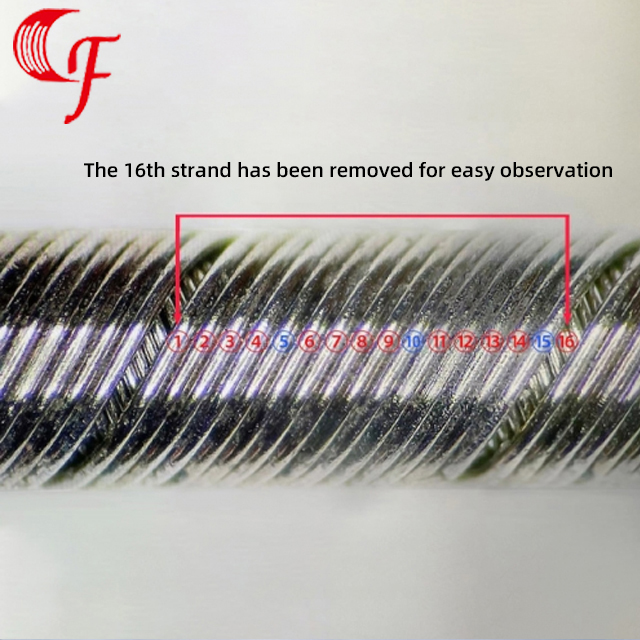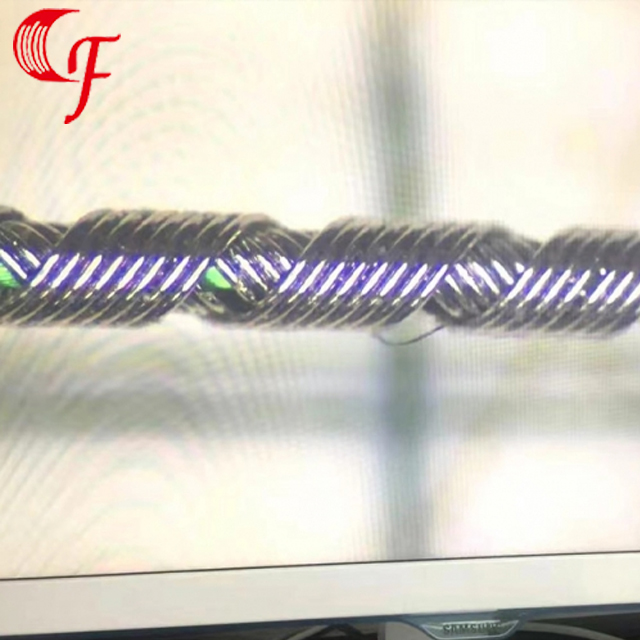Surface treatment method for inclined coil springs
Date:2019-07-09 Author: click:

Surface treatment method for inclined coil springs
The corrosion of inclined coil spring can be divided into chemical corrosion and electrochemical corrosion according to its reaction type. They are the result of changes in metal atoms on the surface of the spring or of electron gains and losses becoming ionic states.
If the metal on the surface of the spring simply reacts with the surrounding medium, and the spring causes corrosion, it is called chemical corrosion. For example, the spring oxidizes to form an oxide film in a particularly dry atmosphere, and the spring changes chemically with the liquid or the impurities in the liquid in a non-electrolyte liquid, which belongs to chemical corrosion.
If the spring is in contact with the electrolyte solution, the corrosion caused by the action of the microcell is called electrochemical corrosion. For example, the spring and acid or salt solution contact, this kind of solution is electrolyte, due to the spring surface defects or impurities and other reasons to form a potential difference electrode so that the spring is constantly subjected to electrolytic corrosion; Another example is the spring in the humid atmosphere, due to the water vapor in the atmosphere on the surface of the spring condensed into water film or water beads, coupled with the corrosive gases in the atmosphere (such as sulfur dioxide and hydrogen sulfide in industrial waste gas or salt spray in the ocean atmosphere, etc.) dissolved in the water film or water beads to form electrolytes. In addition, the impurities or defects of the spring metal can also form electrodes with different potential differences, and the spring also produces electrolytic corrosion. These are electrochemical corrosion.
The chemical corrosion of the spring is small and slow, while the electrochemical corrosion is the main and common. But generally speaking chemical corrosion and electrochemical corrosion exist simultaneously.
Spring in the manufacturing, storage, use and other processes, often suffer from the surrounding medium corrosion. Because spring in the work is to rely on the elastic force to play a role, spring corrosion after the elastic force will change and lose function. Therefore, preventing the corrosion of the spring can ensure the stability of the spring and extend its service life.
The spring anticorrosion method generally uses the protective layer, according to the nature of the protective layer can be divided into: metal protective layer, chemical protective layer, non-metal protective layer and temporary protective layer, etc., in this focus on the first three methods.
Stainless steel spring and copper wire spring itself has a certain anti-corrosion ability, so generally do not carry out anti-corrosion treatment.
1. Metal protective layer of spring
There are many kinds of metal protective layer, as far as the spring is concerned, it is generally electroplated method to obtain the metal protective layer. Electroplating can not only protect against corrosion, but also improve the appearance of the spring. Some electroplated metals can also improve the working performance of the spring, such as improving the surface hardness, increasing the resistance to wear, improving the thermal stability, preventing radiation corrosion and so on. But if only for the spring corrosion, generally should choose galvanizing layer and electroplating cadmium layer.
Zinc in dry air more stable, almost no change, not easy to change color. A white film of zinc oxide or zinc carbonic acid forms in moist air. This dense film protects against further corrosion. Therefore, galvanized layer is used for spring corrosion protection under general atmospheric conditions. Where and sulfuric acid, hydrochloric acid, caustic soda and other solutions in contact, as well as in the atmosphere of sulfur trioxide in the humid air of the spring, should not be used zinc plating.
Generally galvanized layer after passivation treatment, passivation can improve the protective properties of the coating and increase the surface appearance.
In the Marine or high temperature atmosphere, as well as the spring in contact with sea water, the spring used in 70°C hot water, cadmium is relatively stable, strong corrosion resistance. Cadmium coating is brighter and more beautiful than zinc coating, and its plasticity is better than zinc coating. It has less hydrogen brittleness and is most suitable for spring as protective layer. But cadmium is rare, expensive, and cadmium salt is very toxic to the environment pollution is very serious. Therefore, it is limited in use. Therefore, most of the spring used in aviation, Marine and electronic industries only use cadmium coating as a protective layer.
In order to improve the corrosion resistance of cadmium coating, passivation treatment can be carried out after plating.
The thickness of zinc and cadmium coatings determines the protection ability. Generally, the thickness should be selected according to the working environment, and the hardness of galvanized layer is recommended to be selected in the range of 6-24 μm. The recommended thickness of cadmium plating layer is 6~12μm.
Galvanizing and cadmium plating of springs is done in cyanide electrolyte. In the plating process, in addition to zinc or cadmium plating, a part of reduced hydrogen penetrates into the lattice of the coating and base metal, causing internal stress and making the coating and spring on the spring brittle, also known as hydrogen embrittlement. Due to the high strength of the spring material, coupled with the large deformation of the spring forming, it is particularly sensitive to hydrogen embrittlement. If the hydrogen is not removed in time, it will often cause the fracture of the spring. In order to eliminate some defects produced in the electroplating process, improve the physical and chemical properties of the spring, extend the service life of the spring, and improve the corrosion resistance of the coating, it is necessary to carry out plating post-treatment, that is, hydrogen removal treatment. Hydrogen removal is done immediately after electroplating or within a few hours. The electroplated spring in the temperature of 200~215°C, heating 1~2h (or more than 2h, if the time is too long prone to chromium brittle), you can achieve the purpose of hydrogen removal.
Hydrogen removal is generally carried out in an oven. The effect of hydrogen removal is related to temperature, time and residence time after electroplating. Generally speaking, high temperature, long heating time, short pause time after plating, the hydrogen removal effect is good. Therefore, the spring hydrogen removal temperature can be selected higher.
Metal protective layer, in addition to the above galvanized and cadmium plating, there are copper plating, chromium plating, nickel plating, tin plating, silver plating, galvanized titanium alloy, etc. The spring designer can choose the plating according to the spring working occasion.








